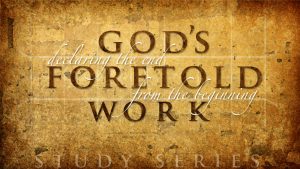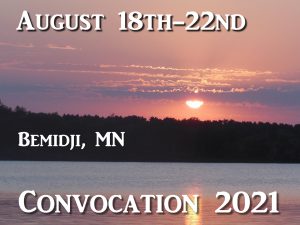It should be well known from the prophetic portions of both testaments, that the age concludes over an international crisis concerning the Land, and Jerusalem in particular. Shepherds and leaders, and witnesses in general are going to need an answer for why this should be so.
As never before, the whole flow of history is moving exactly in the direction that the plain person’s plain reading of prophecy would have led them to expect. God Himself has made the issue of Israel and the so-called, “Jewish question” a watershed of international division.
Just imagine trying to explain the irrevocable election of Israel, based on grace alone, to a generation that is being fast pre-conditioned, almost overnight, to despise the very suggestion of such an unthinkable notion. Talk about a calculated offense!
So yes, how we see the times we’re in does indeed come down to a question of one’s hermeneutics, but also to a question of the heart.
The pragmatic pastor will want to ask, how is this relevant to the gospel? If a pure gospel is well established in the heart, isn’t that enough? Shouldn’t such details of prophetic speculation be left to the mystery that God intended, nice to know but not critical, since the sheep will surely make it through, come what may?
Indeed, the gospel and the saving righteousness of Christ is centermost. But this center has a Divinely chosen context that must not be neglected, not only for our benefit, but much more importantly, for the glory that God has invested in His foretold plan, precious to savor at all times, but particularly now, as chaos and deception is about to explode on a scale eclipsing anything ever witnessed before.
We must remember that the NT revelation of the mystery of the gospel is built around Christ’s coming, departure, and return to Israel, specifically the Mount of Olives from whence He ascended. He must return to the place where He was crucified under the placard that said, “This is Jesus of Nazareth, the King of the Jews.”
Why end the age just there, in that physical locality? Why has God constructed the end of the age around an ancient land dispute that is divinely calculated to plunge the nations into an insoluble crisis from which none will be able to extricate themselves? (Zech 12:2-3). Why would God bind together the issue of the mystery of the gospel with the mystery of Israel?
I would submit that part of the answer regards His deliberate intention that both comings would be surrounded by an element of mystery, designed to elude the pride of self-reliance (Mt 11:25-26), just as Paul warns in Ro 11:25. Just as the mystery of Christ’s twofold coming so deeply searched and tested Jewish hearts, just so, the mystery of Israel is designed to test and sift the hearts of the nations, even gentile believers.
But there is one important difference: The mystery of Christ’s cross and twofold coming was not only hidden from Peter and the disciples (Mt 16:22; Lk 18:34); it was hidden even from the angelic powers (1Cor 2:7-8). Not so the mystery surrounding the Lord’s return.
Those well marked days will only come “as a thief” upon the unregenerate church and the unbelieving world, but not upon the faithful children of the light (1Thes 5:4). We know this because Daniel’s prophecy is clear that the vision will be unsealed and known to the wise (maskilim) at the time of the end. They will be doing great exploits, instructing many, and turning many to righteousness, even a countless number will be saved out of, “the tribulation, the great one” (Rev 7:14; noting the significant double use of the definite article).
But the larger answer to the question has all to do with the completion of an ancient covenant promise. It is the age-ending climax of the “everlasting covenant” that forms the framework of the future. In the larger context of God’s eternal purpose in Christ, this is what defines how and why the age ends just as the prophecy of both testaments so fully describes.
Towards the goal of seeing the big picture, I believe the Lord Jesus Himself has given us the key to establish what I like to call a “plumbline of simplicity” that will align and pull many of the strands together into a coherent clarity. The object will not only be to know what is most important to know, but how best to show others how to make the case from scripture without getting bogged down in details, in a way that will equip others to equip others.
If observed, I believe God has given us an amazing, and now especially timely, provision to equip the body, not only to escape the manifold forms of end-time deception, but to have the Lord’s own, personally commended key of interpretation that will enable them to “instruct many” and “turn many” to righteousness” (Dan 11:32-33; 12:3, 10).
I would like to expand a little on how Daniel aligns and sets in order, not only the end-time events, but also the whole covenantal framework of the judgments and promises, as traced from Gen 3:15 to the final perfection of the last two chapters of Revelation.
Daniel is the key to organizing the whole of scripture around the main themes of kingdom, covenant, and mystery. But it is Jesus’ Olivet prophecy in particular, and the emphasis He puts on one centermost event, that becomes the key that opens not only Daniel, but also sets all the prophecies spoken concerning the coming day of the Lord in clearest covenant context.
Referencing and building upon Moses and the earlier prophets, Daniel gives us not only the timeline and the order of events related to both comings, but he also reminds us of the covenant curses that must continue until Israel’s everlasting deliverance and final security in the Land, all in glorious analogy to the story of Joseph and his brothers (compare Mic 5:3-4, with Zech 12:10).
Rightly instructed believers will weep with those who weep, not only in their bitter distress, but in the glory that will break upon the beleaguered survivors of Israel when they will look upon Him whom they pierced and say with one voice, “Blessed is He who comes in the name of the Lord!” (Mt 23:39).
In this way, we can begin to see God’s mind and purpose behind the great judgments and the unrestrained evils that would be otherwise inexplicable, and the occasion for the greatest offense to the natural mind.
But back to my point:
In my experience I found that when I chose to take very seriously Jesus’ command to read and understand Daniel’s prophecy concerning the abomination of desolation, I was challenged when I saw that this light did not come to him until he first, “set his heart to understand”. Looking to understand this particular event and its full significance, I would be astonished at just how much more this simple obedience would open to discovery in pulling the great strands of biblical themes together. Jesus well knew what simple compliance to His wise directive to pay attention to Daniel would set in motion.
Not only did I discover the event, and the events that follow throughout the second half of the week, I discovered a number of events that would mark and distinguish the first half. What a priceless advantage this first half of the week will provide the body for their readiness for the second half. We will see it coming!
But more than all of this, Daniel became the key to what I like to call, “the glory of the story”. This is because Daniel, like no other book, reaches all the way back to Israel’s beginnings and outlines the whole sweep of Israel’s history of crisis and covenant discipline, reaching to its glorious resolution in the kingdom that has come on earth as it is in heaven.
It is important to note that the abomination of desolation is the very event that Paul was careful to elaborate during his short, three-week stay with the Thessalonians. This should underscore the importance he attached to Jesus’ Olivet prophecy and His emphasis on Daniel’s order of events.
We know this because when the false alarm arose that Christ’s return was immediately imminent, he corrected the error by appealing to what he had gone over with them on his earlier visit. “Do you not remember that when I was yet with you, I told you these things?” (2Thes 2:5).
Paul speaks of a coming man who is yet to be revealed. He will be possessed of “all power”, capable of signs, wonders, and cunning deception. He will enter the temple of God in Jerusalem (Mt 24:15-16), and there, exalt himself above all that is called God or that is worshipped (2Thes 2:4). But there are some dots we need to connect.
Jesus doesn’t mention the man, but only this event and its location (“Judea”). But both Paul and Jesus use language that is taken almost verbatim from Daniel chapter 11, where both the man and the event are described within four verses of each other (see Dan 11:31-37). So the scripture itself shows us how the dots should be connected.
Manifestly, Paul did not regard knowledge of the basic order of endtime events as a matter of no serious concern. Notice Paul’s urgent tone when he echoes the Lord’s similar grave warnings concerning the peril of deception on this very matter. “Let no man deceive you by any means!”
You can almost hear the exclamation point.
That sounds like the beginning of Jesus’ opening answer to His disciple’s question, “What shall be the sign of your coming and the end of the age?” Significantly, Jesus’ first words were, “take heed that no man deceive you”, again, the exclamation point. No other theme is so repeatedly reinforced throughout His prophetic discourse.
Paul’s response to the error concerning the order of events preceding the Lord’s return implies that something far more serious was being threatened than to merely prompt the slackers and busybodies to return to their ‘day jobs’ and occupy till He comes, as some commentators seem content to assume. Rather, Paul is seeing where this error can lead in light of the confusion that Jesus warned would reign, particularly over thie time and manner of His return (Mt 24:23-31).
The abomination of desolation is THE prophetic key to the believer’s preparation to instruct many of the meaning, not only of the events of those days, but the great issue of the promise of an “everlasting righteousness” that is the Lord’s own righteousness, available to believers now, but promised to come to all the penitent survivors of Israel in that great day (Isa 45:17, 24-25; 54:17, Jer 23:5-6; Dan 9:24). This is the glorious free gift that gives hope and meaning and comfort, even in the face of the staggering evil, deception, and suffering of those days, like the shattering event we so recently witnessed on Oct 7, a tragic foretaste of Zech 14:2.
But clarity concerning this decisive event achieves much more than might first appear. The abomination of desolation cannot happen in a vacuum. It must be preceded by certain definite, traceable events and preconditions.
For one thing, before a sacrifice can be removed it must exist. If it does not now exist, it must start. But before it can start, a long-standing stalemate must yield to a radical change in the current status quo. For these kinds of necessary preliminary conditions to come about, we may expect seismic changes to come to the region, sufficient to move nations from their former intransigence to make unprecedented concessions for peace.
The logic is clear. In order for the Jews to have sufficient access to the forbidden Temple Mount, some kind of political peace arrangement, however presently remote, seems necessarily implied, and indeed foretold in scripture (compare Isa 28:15, 18; Eze 38:8, 11, 14; 39:26; Dan 9:27; 11:21, 23-24, 31; Mt 24:15-16; 1Thes 5:3). You see then how those who will have obeyed the Lord’s command to search out and understand this particular event foretold by Daniel, will also be able to recognize at least some of the preceding events that signal its approach.
This is where an understanding of Daniel’s 70th week will prove invaluable for the church’s readiness. For this, we must see God’s investment in the first half of the week as a divine strategy to prepare the church for the second half. But for this, we must see that the 70th week did not follow the 69th week in unbroken succession.
I will give only the briefest possible argument why the 70th week must be seen as future. The basic, highly condensed argument is this:
Dan 12:1-2, 7, 11, particularly vers 11, will show beyond reasonable dispute that the abomination of desolation, with the simultaneous removal of the daily sacrifice, starts the last 3 ½ years (the half week of Dan 7:25; 9:27; 12:7; Rev 11:2-3; 12:6, 14; 13:5). It is the ‘time like no other’, also called, “great tribulation” and “the time of Jacob’s trouble” (Jer 30:7; Dan 12:1; Mt 24:21: Rev 7:14).
Observe that this last and greatest tribulation on earth ends with nothing short of the final deliverance of Daniel’s people and the resurrection of the righteous dead, including Daniel’s personal resurrection (Dan 12:1-2, 13). Thus, it is not far to see that this is the event that divides the final week in two equal halves in Dan 9:27.
So far as it is agreed that the 69th week terminates at the cross of Christ (i.e., Messiah “cut off”; Dan 9:26 with Isa 53:8), nothing within the range of the seven years following the cross arrived at the kind of “end” / “consummation” as described in Daniel, most particularly Dan 12:1-2. Advocates of the unbroken continuity of the 70 sevens are hard pressed to identify what events within that time frame can be said to fulfill the goals reached at the end of final the 3 ½ years, most specifically and undeniably the deliverance of Daniel’s people (Jews / “natural branches”) and the resurrection of the righteous (Dan 12:1-2, 7, 11).
Therefore, to speak of an unbroken continuity between the 69th and 70th weeks is highly anticlimactic, to say the least. Such would be a complete short-fall of the end goals, not only of Dan 9:24, but of Daniel’s apocalyptic visions in general, all of which were aimed at the final and eternal end of exile and the coming in of the post-tribulational kingdom of God on earth at the end of the last persecution.
Time forbids an account of the genius and logic of all six goals of the seventy sevens (Dan 9:24) and the mystery of the interim that divides the 70th seven from the former 69 weeks of years, but for now, our purpose must be limited to underscore how invaluable this knowledge will be in preparing the church, now, but even more especially in the first half of the week for what it must be to Israel and the nations in the second half that ends in Christ’s post-tribulational return at the Day of the Lord.
This strategic advantage threatens to be lost to the church’s benefit unless we are able to identify the distinguishing markers that show we have entered into the first half of the week. I offer this brief quote from G. H. Lang (beloved mentor of F. F. Bruce) from his, “The Histories and Prophecies of Daniel”:
“When this agreement shall have been confirmed, the wise will know that the final seven years has commenced, that the end days are present, that the consummation of the age has arrived. They will expect the violation of the covenant after three years and a half, and will not be overwhelmed with surprise, having been told beforehand by this prophecy. Then will it be seen in fullness that the knowledge of prophetic scripture is simply priceless.”
I conclude with this appeal: Certainly every inch of ground in the confusing smorgasbord of eschatological options is hard fought and hard won, but there are keys of simplicity that make a plain path through the maze. One of those keys I have mentioned, but just how best to use that key to equip the church belongs to another discussion.
But regardless, whether you believe the preterist position that the abomination and the great tribulation is past already, or the classic dispensational view that the Olivet prophecy is to be seen as “Jewish ground”, not directly applicable to the church that is expected to be gone during this time. In any event, I soberly appeal to you to at least treat the grave warnings of deception and the antidote that Jesus prescribes with at least a ‘just in case’ sense of responsibility for the sake of your flocks.
If Jesus put such stress on the relationship of this event to offset some of the prevailing deceptions of “those days”, such as the present massive upsurge of antisemitism, just reflect on how regrettable it would be if you had failed to prepare those under your care with at least the means to recognize these things if you might just happen to be sincerely mistaken.
All’s to say, a careful knowledge of Daniel’s prophecy of the end is a pain well worth taking. It is only as we are instructed that we will be in a position to instruct (Dan 11:33; 12:3).
If Paul can rightly call the living church of the living God “the pillar and ground of truth” (1Tim 3:15), it would seem inconceivable that the last witness of the gospel to Israel and the nations would be made in its absence. If we take the view that to be alive “in Christ”, whether before, during, or after the tribulation, is necessarily to be part of His body, then it follows that “the voice of the bridegroom AND of the bride” (Rev 18:23) will be heard far and wide during a final witness, sealed in the blood of the tribulation martyrs (compare Dan 7:21; 11:35; 12:10; Mt 24:14; Rev 6:10-11; 12:11; 13:7, 15; 14:6; 20:4).





